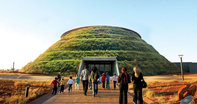
The South African landscape is as beautiful as it is diverse. It has an endless abundance of natural wonders - mountains, forests, rock formations, beaches, deserts and various other geological features. South Africa boasts with eight World Heritage Sites, allocated by the United Nations Educational, Scientific and Cultural Organization. These places hold geological and cultural significance that, according to UNESCO, deserve an honorable mention and protection above national level.
One of the most well known South African World Heritage Sites is Robben Island, best known as a prison where anti-apartheid revolutionary Nelson Mandela served 27 years as a political prisoner. The island’s historic significance dates back to the 17th century, when it was used as stop for travelling sailors to replenish food supplies.
Those who committed crimes aboard a ship who be dropped off at the island as punishment, and after European settlers invaded South Africa the island was a prison for indigenous Xhosa people during the Eastern Frontier Wars. It later became a place for lepers, served as a mental hospital and a World War 2 fort before it became an apartheid political prison.
Other South African World Heritage Sites include the Cradle of Humankind, iSimangaliso Wetland Park, uKhahlamba / Drakensberg Park, Table Mountain National Park, Cape Floral Region Protected Areas, Vredefort Dome and the Richtersveld Cultural and Botanical Landscape.
South Africa Online ® offers extensive information on all eight World Heritage Sites, reiterating their fascinating history, cultural and geological significance.
 The Baviaanskloof Nature Reserve, a World Heritage Site, part of the Baviaanskloof Mega Reserve, lies roughly 120 km west of Port Elizabeth ...
The Baviaanskloof Nature Reserve, a World Heritage Site, part of the Baviaanskloof Mega Reserve, lies roughly 120 km west of Port Elizabeth ... If you’ve not visited the Cradle of Humankind World Heritage Site before, near Krugersdorp/Mogale, you’re in for a real treat. This rema...
If you’ve not visited the Cradle of Humankind World Heritage Site before, near Krugersdorp/Mogale, you’re in for a real treat. This rema... iSimangaliso Wetland Park must be the only place on the globe where the world’s oldest land mammal (the Rhinoceros) and the world’s bigg...
iSimangaliso Wetland Park must be the only place on the globe where the world’s oldest land mammal (the Rhinoceros) and the world’s bigg... This alluring, inspiring and overwhelming region hides an incredible World Heritage Site in South Africa called Mapungubwe National Park, ri...
This alluring, inspiring and overwhelming region hides an incredible World Heritage Site in South Africa called Mapungubwe National Park, ri... Situated in the extreme northwest corner of South Africa, and hunkered down within the muddy embrace of the Orange River, you will find the ...
Situated in the extreme northwest corner of South Africa, and hunkered down within the muddy embrace of the Orange River, you will find the ... Robben Island is located a short distance off the coast of Cape Town. It is within sight of Table Bay, Bloubergstrand, Sea Point and Camps B...
Robben Island is located a short distance off the coast of Cape Town. It is within sight of Table Bay, Bloubergstrand, Sea Point and Camps B... Around two billion years ago, a meteorite about the size of Table Mountain hit the earth near to where the town of Vredefort stands today, i...
Around two billion years ago, a meteorite about the size of Table Mountain hit the earth near to where the town of Vredefort stands today, i...